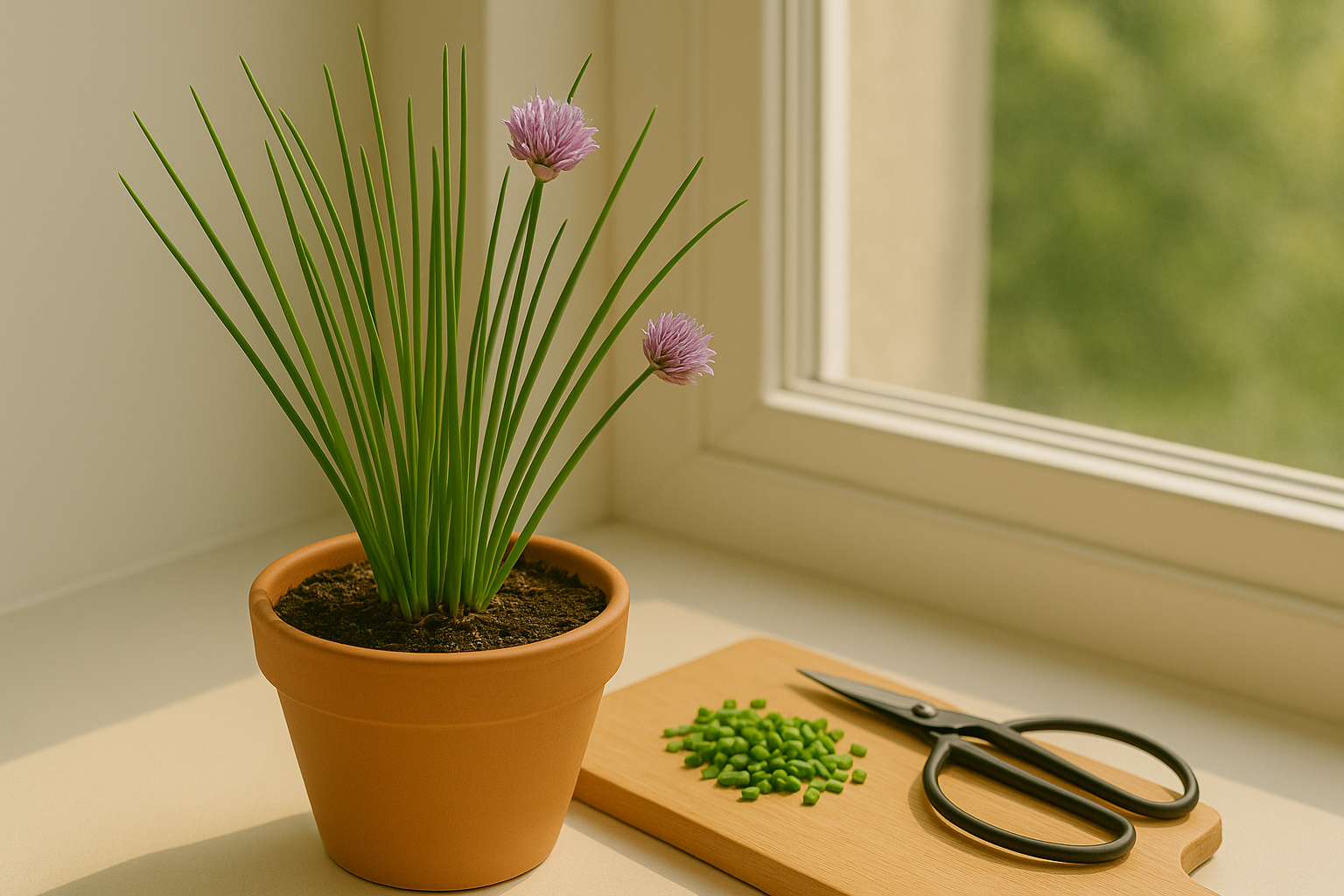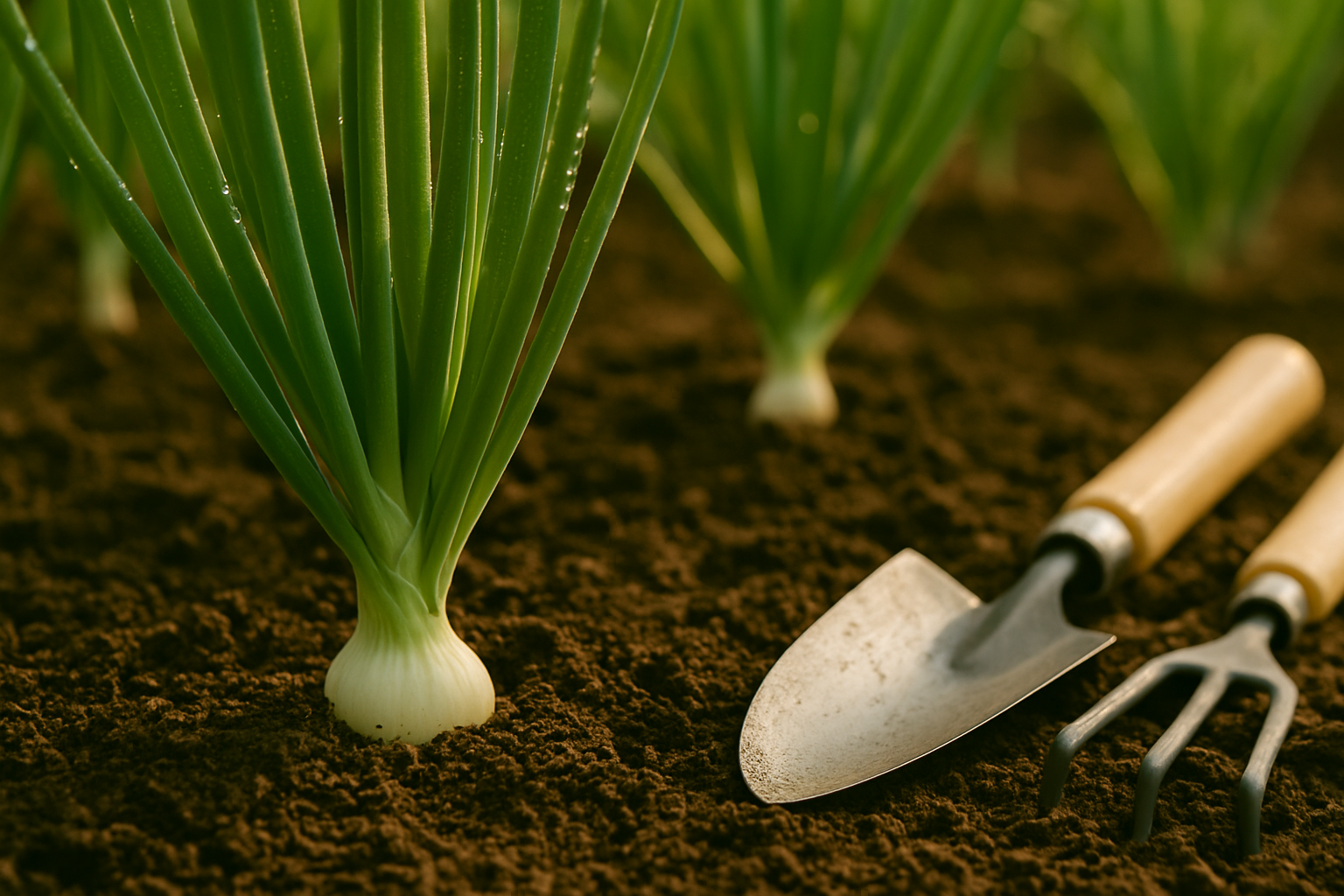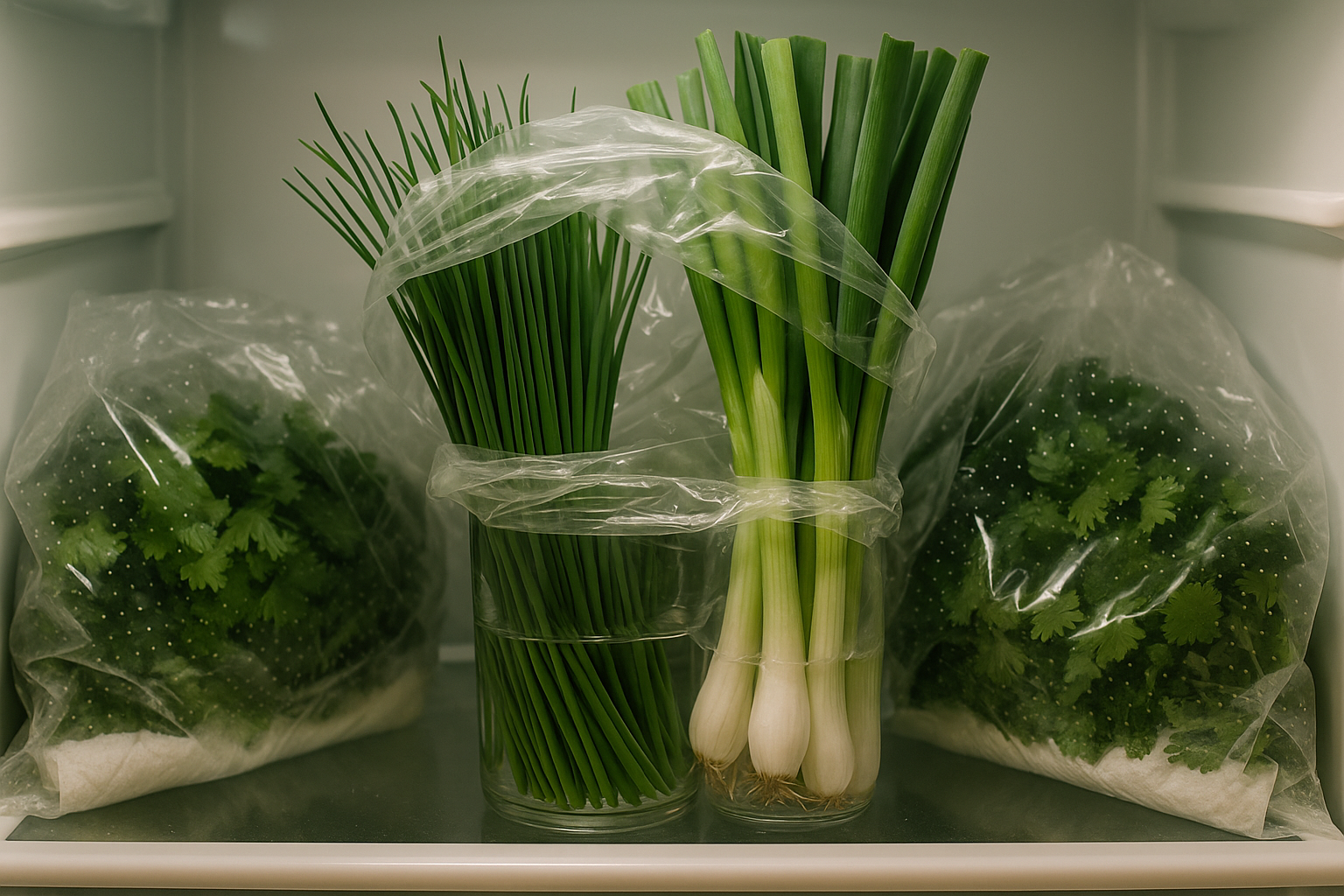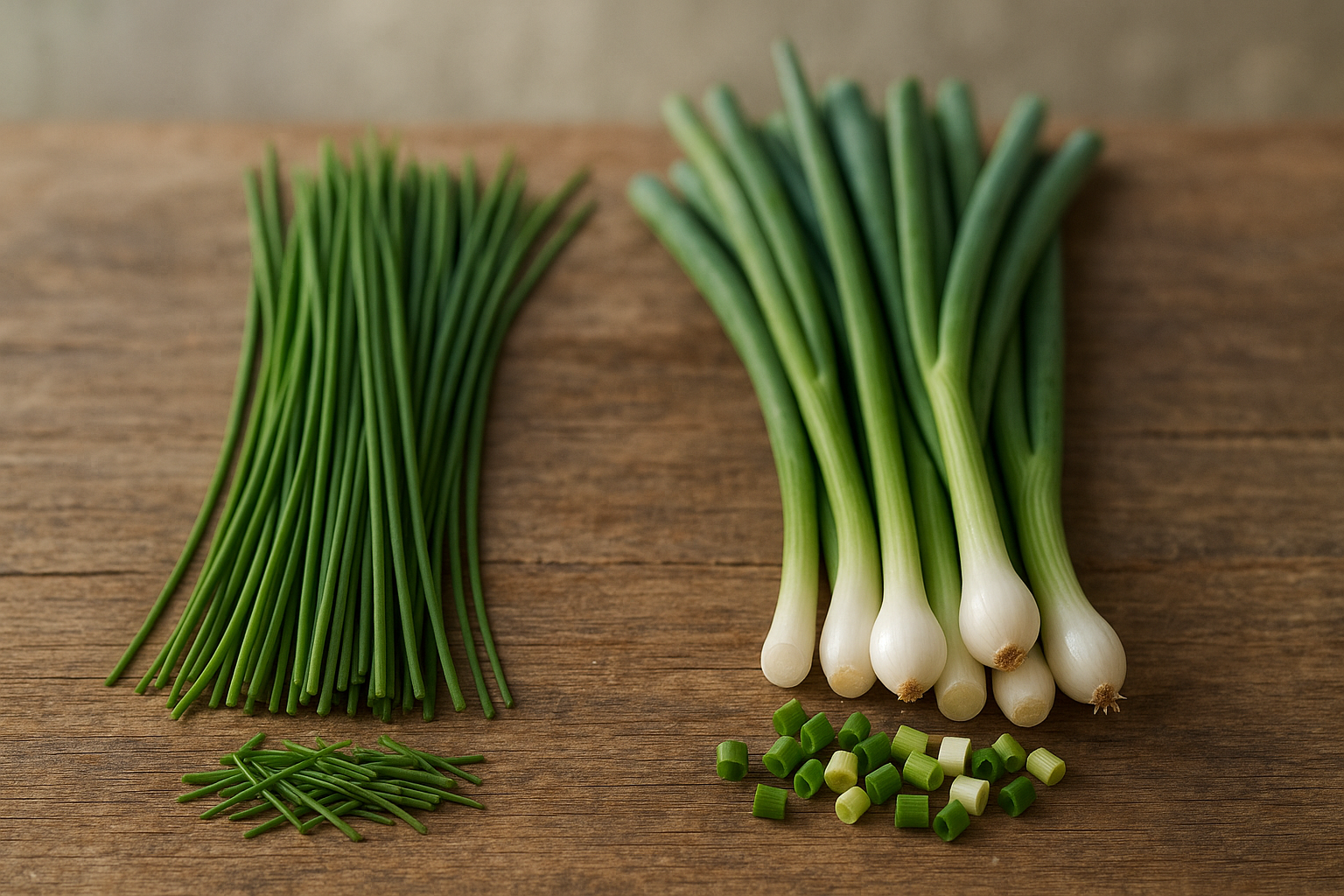Chives and Green Onions
Chives and green onions often get mixed up in the kitchen, but telling them apart is easier once you know what to look for. Chives are slim, hollow, and delicate green stalks, while green onions (also called scallions) have thicker, tubular stalks and small, white bulbous bases.
The flavor is another giveaway: chives lend a mild, oniony note with hints of garlic, making them ideal for garnishing baked potatoes, eggs, or soups right before serving. Green onions, on the other hand, have a more pronounced onion flavor and can be used raw or cooked—the white ends offer a stronger punch, while the green tops are milder and perfect for sprinkling onto salads or stir-fries.
Recognizing the difference is important because each ingredient can change the balance of your dish. For example, substituting green onions for chives in a delicate cream sauce might overpower it, while using chives in a stir-fry won’t give you the same aromatic depth or texture.
When shopping, remember:
- Chives are usually sold in smaller, finer bunches.
- Green onions come in larger bundles with more prominent roots.
Choosing the right one helps ensure your recipes turn out just as intended.
What Are Chives?

Chives are slender, bright green, grass-like herbs with hollow stems, often used to top dishes with a mild onion-garlic flavor that’s fresh and subtle. They belong to the Allium family—alongside onions, garlic, and leeks. Chives (Allium schoenoprasum) are a perennial plant native to Europe, Asia, and North America, thriving in temperate climates and easily grown in backyard gardens or pots on sunny windowsills.
Their delicate purple blossoms are also edible and add a pop of color to salads. In the kitchen, chives are a versatile garnish: sprinkle them over baked potatoes, scrambled eggs, creamy soups, or mix them into dips and salads for a burst of brightness without overpowering other flavors.
They are best used fresh since high heat can diminish their flavor, so add them at the end of cooking. Nutritionally, chives pack a surprising punch—offering vitamins A, C, and K, along with antioxidants believed to support immune health.
For a quick boost, chop a handful into cream cheese for a homemade spread or top grilled fish for a zesty finish. Whether you’re a home cook or a novice gardener, chives are an easy way to elevate your meals and sneak in a few extra nutrients.
What Are Green Onions (Scallions)?

Green onions, also known as scallions, are a popular allium vegetable recognized for their long, slender stalks and small white bulbs, both of which are commonly used in cooking. Unlike regular onions that develop larger, rounded bulbs with thick, papery skins, green onions are harvested early while their bulbs are still immature. This results in a milder flavor and a crisp, tender texture.
The green tops are hollow and grassy, resembling chives, but green onions are generally larger. Both their stems and bulbs are edible, whereas chives are mainly used for their thin, grass-like leaves, adding a lighter onion note.
Scallions grow in clusters and thrive in well-drained soil, often ready to eat about a month after planting. Their fresh, mild flavor offers a subtle onion kick without overpowering dishes, making them perfect for garnishing soups, stir-fries, salads, tacos, and omelets.
Pro tip: Add green onions at the end of cooking to preserve their color and crunch, or use both the white and green parts for a balance of bite and freshness. Whether sprinkled raw or cooked briefly, their versatility and gentle zing make scallions a staple in kitchens around the world.
Chives vs Green Onions
Chives and green onions are often confused in the kitchen, but they each bring unique qualities to your dishes. In terms of flavor, chives offer a delicate onion-like taste with subtle garlicky notes, making them perfect as a fresh garnish for soups, baked potatoes, and omelets. Green onions, also called scallions, have a more pronounced, peppery onion flavor—especially in the white bulb—while their leafy tops are milder.
Appearance plays a big role in telling them apart: chives are thin, grass-like strands with hollow stems and no visible bulb, whereas green onions have straight, tubular green tops and a small white base that’s sometimes just beginning to bulb.
Botanically, chives (Allium schoenoprasum) are a distinct species in the allium family, closely related to garlic and leeks. Green onions (Allium fistulosum) are more closely related to onions and, sometimes, varieties of spring onions.
Nutritionally, both are low in calories and rich in vitamins K and C, but green onions tend to have more fiber and a slightly firmer texture. Chives, by comparison, are finer and softer—ideal for adding a burst of flavor without changing the dish’s texture.
It’s common to confuse these with spring onions, which look like larger green onions with rounder bulbs and a sharper flavor. Understanding these subtle differences can help you choose the right herb or vegetable for your next recipe, ensuring the best flavor and presentation every time.
How to Use Chives and Green Onions in Cooking

Chives and green onions add vibrant flavor and color to countless dishes, making them kitchen staples, but their uses can differ. Chives, with their delicate, mild onion flavor, shine as garnishes on baked potatoes, creamy soups, eggs, or even creamy dips. Their fine, hollow stems are best snipped with scissors and sprinkled fresh, as overcooking dulls their subtle taste.
Green onions (also called scallions) have a sharper, more assertive bite and can be enjoyed raw in salads, salsas, or stir-fries, or cooked into omelets, fried rice, and noodle dishes. Both can be used interchangeably in garnishes and cold dishes—just slice green onions finely if subbing for chives, and use a little less due to their stronger flavor.
Chives pair beautifully with dairy (think sour cream, cream cheese, or butter), while green onions play well with Asian flavors like soy sauce, ginger, or sesame oil. For a unique twist, try chive oil drizzled over grilled fish or green onion pancakes for a savory snack. Mixing chives into mashed potatoes or using green onions as a topping for tacos can quickly elevate simple meals.
Don’t be afraid to experiment—these herbs provide a boost of freshness to almost any recipe.
Proper Storage Tips for Maximum Freshness

To keep chives and green onions fresh for as long as possible, proper storage is key. Refrigerate both by wrapping them loosely in a damp paper towel and placing them in an open plastic bag or a perforated produce bag—this helps them stay crisp and hydrated for up to a week.
For a longer shelf life, chop and freeze them in an airtight container or ice cube tray with a splash of water or olive oil; frozen, they’ll last for several months and are perfect for cooked dishes.
To further extend freshness, trim the root ends and stand the bunch upright in a glass of water (like a bouquet) in the fridge, covering loosely with a plastic bag.
Check regularly for wilted, slimy, or discolored leaves, which are signs of spoilage. Discard any with an off smell or mushy texture, and always wash before use to ensure maximum freshness and flavor.
The Takeaway
Chives and green onions may look similar, but they each bring distinct flavors and uses to the kitchen. Chives are delicate, with a mild, grassy, onion-like taste—perfect as a fresh garnish on eggs, baked potatoes, or creamy dips.
Green onions, also called scallions, have a bolder and more versatile flavor. Both their white and green parts can be cooked or eaten raw in stir-fries, salads, and soups.
When deciding which to use, consider the flavor you want:
- Chives for subtlety and a pop of color
- Green onions for a stronger bite and a bit more crunch
Don’t be afraid to experiment—if you’re out of one, the other can often stand in, though you may notice a slight difference in taste. Fun fact: both chives and green onions are easy to regrow at home; just place the roots in water and watch them sprout again!
